For a long time, gaming and e-sports in India have been niche activities, at least when compared to the likes of Europe, US, South Korea and China. However, that looks to be changing as gaming on a professional level is starting to be encouraged in India and big e-sporting events such as DreamHack make their way to the country. Asus is a pioneer in making gaming hardware and is deeply involved in gaming. In fact, the Asus Republic of Gamers (ROG) brand specifically caters to gamers in general and PC gamers in particular. ROG products tend to be the top of the stack, the best of the best hardware that Asus sells, and of course, they all feature RGB lighting in some form or the other. The one area that the ROG brand has, so far, stayed out of, is mobile gaming.
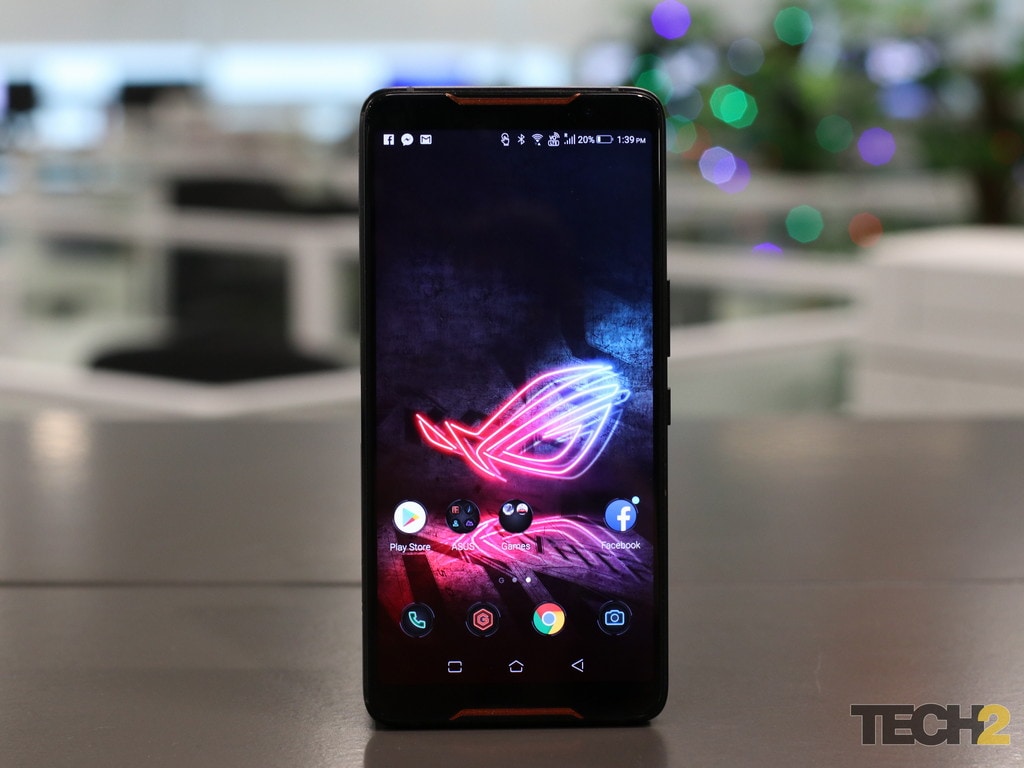
The Asus ROG Phone. Image: tech2/Kshitij Pujari
Now with time, we are seeing quite a shift in the gaming industry. As smartphones get more powerful and as the PC continues to wane in popularity, gaming has shifted to mobile. Despite that, mobile gaming has been plagued with underwhelming titles that could never capture the true, competitive spirit of PC games like Counter-Strike or DOTA. All that changed when PUBG mobile came on the scene. The game was good, but more importantly, it changed perceptions: The phone was suddenly a competitive gaming platform. Naturally, gaming-centric companies like Asus (and Razer before it) wanted in on the action.
Enter the Asus ROG Phone, which has been designed from the inside and outside to suit the profile of gamers, or rather, Asus' perceptions of what a smartphone gamer should expect. While it certainly isn’t the first gamer-centric mobile device to be introduced globally, it is the first of its kind to come to India.
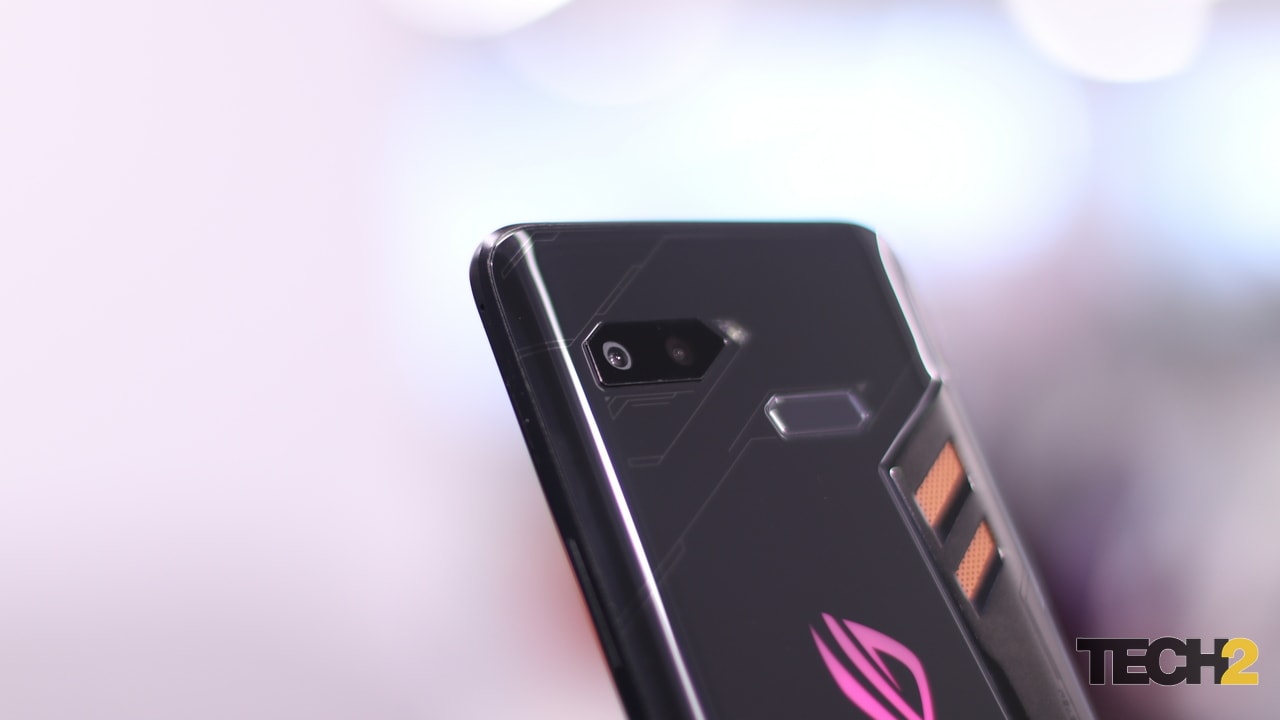
The ROG Phone has an unusual design at the back. Image: tech2/ Kshitij Pujari
Priced at Rs 69,999 the ROG Phone is anything but cheap, and for good reason. This is a customised gaming beast that can fit inside your pocket and enables effortless gaming on the go. Asus has actually gone overboard with some of the tweaks to deliver the "optimum" gaming experience, which ranges from the chipset to the display to the cooling mechanism to even extra ports. Asus is also providing several accessories, including a full-fledged dock to connect peripherals such as a 4K monitor, mouse, keyboard and more to your ROG Phone.
However, no phone is the perfect package and the ROG Phone is no different. While the phone has done plenty right, it has also messed up in certain key areas such as camera and battery. So, is the ROG Phone the perfect mobile gaming companion? I certainly believe so. Should non-gamers invest in the device? Definitely not. Read on to find out why.
Asus ROG Phone Performance: 9/10
I’ll be quite frank here. I don’t think I’ve used a phone that seems as fast as the ROG Phone. It is blazing fast and an absolute joy for mobile gamers such as myself. Benchmarks only tell a part of the story, and while the ROG Phone does have scores that are amazing, they are only marginally higher than other Snapdragon 845 phones on the market. The ROG Phone, however, comes with a speed binned Snapdragon 845 SoC which can be clocked at 2.96 GHz instead of the standard 2.8 GHz. Speed-binning is just another way of saying that ASUS has picked the highest quality Snapdragon 845 chips that were manufactured.
More importantly, what one notices is that the Poco F1, which costs less than a third of the ROG Phone’s price has nearly equal benchmark scores. Obviously, the Poco F1 does not have the large assortment of overkill features that the ROG has, but it is still quite remarkable what Xiaomi has managed to deliver in that price tag. But as I said earlier, benchmarks don’t paint the whole picture.
The ROG Phone in real life is as fast as an Android phone can get. Opening multiple heavy apps at the same time doesn’t affect the phone in any noticeable way at all. One absolutely delightful thing about the phone happens to be that games are always given priority over other apps in the cache memory. This means that I can switch from any app in the phone to PUBG Mobile and it will take me to exactly the same place I left off without restarting the whole game.
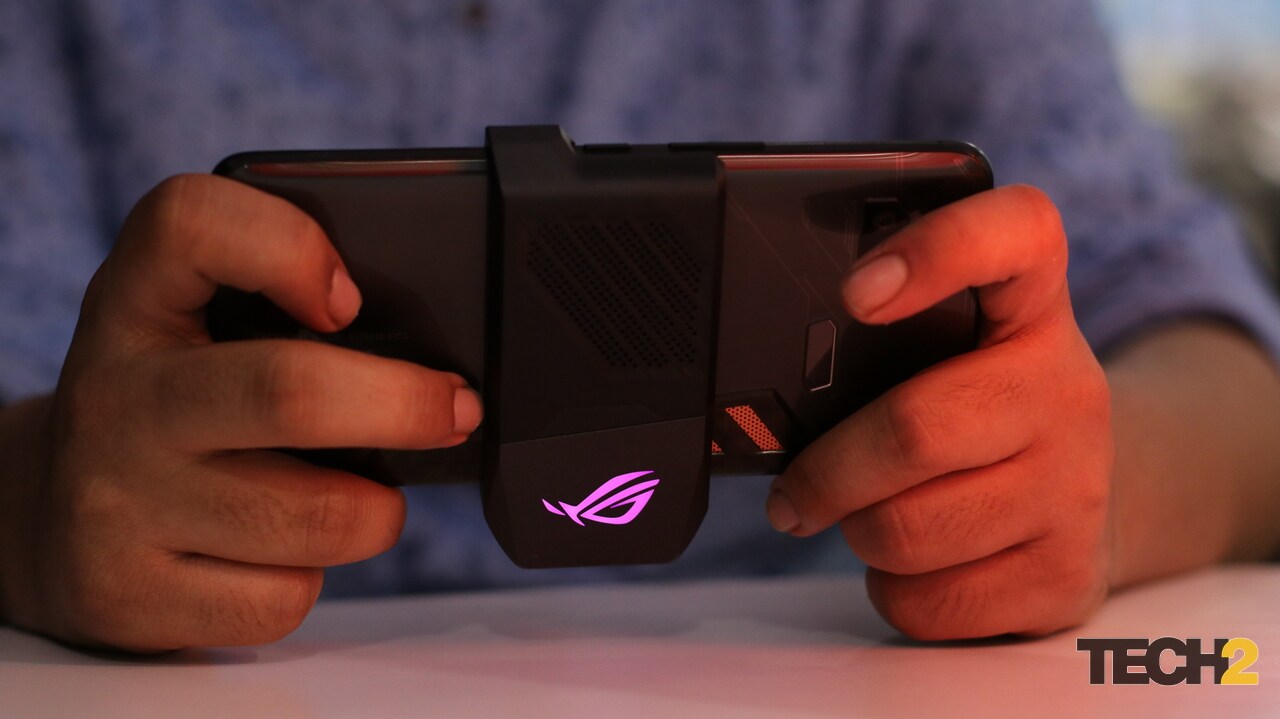
The ROG Phone feels grippy in the hand despite the glass back. Image: tech2/Shomik
I was disappointed to find that the X-Mode (explained in detail later on) is not the performance booster that Asus has marketed it as. Except for giving all the app icons a fancy red glow, X-Mode made no visible difference to the performance of the device. Running the benchmarks on X-mode also gave mildly improved results and what's more, the battery during X-Mode drains quickly as it starts the backlit Aura ROG logo and overclocks the CPU. The 90 Hz display combined with a very bright and punchy display makes this the phone to play games such as Asphalt 9, PUBG Mobile, Shadow of Legends and any other game that requires a lot of graphical grunt. The Adreno 630 and the overclocked CPU perform all tasks without so much as a hiccup. Seriously, I’ve used this phone profusely over the last two weeks and not once did I see it stutter or lag.
Another thing that the ROG Phone includes are air triggers on the side of the phone which can double up as an extra set of buttons. While I had high hopes for this feature, I was a bit let down when the trigger's response time was not the greatest. Even a micro-second delay in games with the intensity of PUBG or Fortnite can be the cause of winning and losing. The air triggers just don't match up with the kind of triggers you see on controllers of PS4 or the Xbox One. A few times the triggers didn't work which has confirmed my feelings of this feature being more or less a gimmick.
The cooling mechanism on the phone is impressive on its own. Two large vents stick out of the back and are part of the ROG Phone’s ‘Aerodynamic System’ which consists of the vapour cooling chamber as well. An overclocked CPU will obviously be the cause of a lot of heating and the cooling methods are in place to check that. However, the phone does get reasonably hot after extended periods of gaming. While checking the game centre before playing PUBG I saw the CPU and GPU temperatures at 32 and 34°C respectively. After running the game for about 30 minutes I saw the temperatures jump up to 49°C and 52°C respectively. On X Mode, the temperatures jumped even higher to 52°C and 56°C for the CPU and GPU respectively. Some of this heat could also be attributed to the additional strain on the battery while in X mode.
The Aeroactive cooler, provided in the box, is a helpful accessory that will not let the temperatures get out of hand. It can be attached to the side of the phone on the proprietary port. It has a USB-C port of its own along with a headphone jack. When attached and running at full tilt, the temperatures were kept at about 43°C and 46°C on X Mode.
The fingerprint sensor on the phone is not the greatest that is out there and neither is the face recognition. Quite a few times the phone could neither recognise my face nor my finger despite multiple attempts and I had to unlock using the pin I had assigned earlier. I'm hoping that this can be improved in future software updates.
Let’s also talk about the audio of the device, which is phenomenal. Listening with earphones on the ROG Phone is truly breathtaking thanks to the DTS:X 7.1 virtual surround sound technology. If paired with good earphones such as the Brainwavz M3, the audio is impressively immersive. This is particularly useful while playing PUBG Mobile, where the sound of nearby enemy players is crucial for pinpointing their location. If earphones are not your go-to thing when gaming, then the amazingly loud dual-speaker system on the phone will certainly blow your mind. It is by far the loudest speaker I’ve heard on a phone and it is impressive how clear the sound is at higher volume levels.

The Asus ROG Phone is lightning fast. Image: tech2/Shomik
Call quality on the earpiece is as good as expected. Performance-wise, the ROG Phone is quite a beast and it shows every time you open a game.
Asus ROG Phone Build and Design: 8.5/10
At first glance, you can see why there was so much hype about the ROG Phone. The phone screams futuristic and in terms of design, truly justifies the ROG branding. Whether it is the cooling vents with the copper accents on the side, the shiny glass back with its prism-like reflections, the glowing ROG logo or the hexagonal fingerprint sensor, you cannot deny that the phone has a certain sense of style to it. The device is heavy and you can blame that on the fancy cooling hardware that's packed in. The 4,000 mAh battery must also be contributing to the weight.
The device feels expensive when held, especially with the rounded edges and glass panels. The power and volume buttons are on the right side of the phone and on the left side you see a USB Type-C port and a proprietary port which can be used to connect all the peripherals that Asus provides with the device. The back isn’t all glass though. A polycarbonate cutout is present at the back which houses the 'ROG Aerodynamic' cooling system which includes two air vents. Speaking of vents, given the holes and the fact that this phone has no IP rating, we recommend that you do not use it near water.
The bottom of the phone reveals another USB Type-C port along with a 3.5 mm headphone jack, the latter of which is refreshing to see as more and more smartphone makers are hopping on the no-audio-jack express.
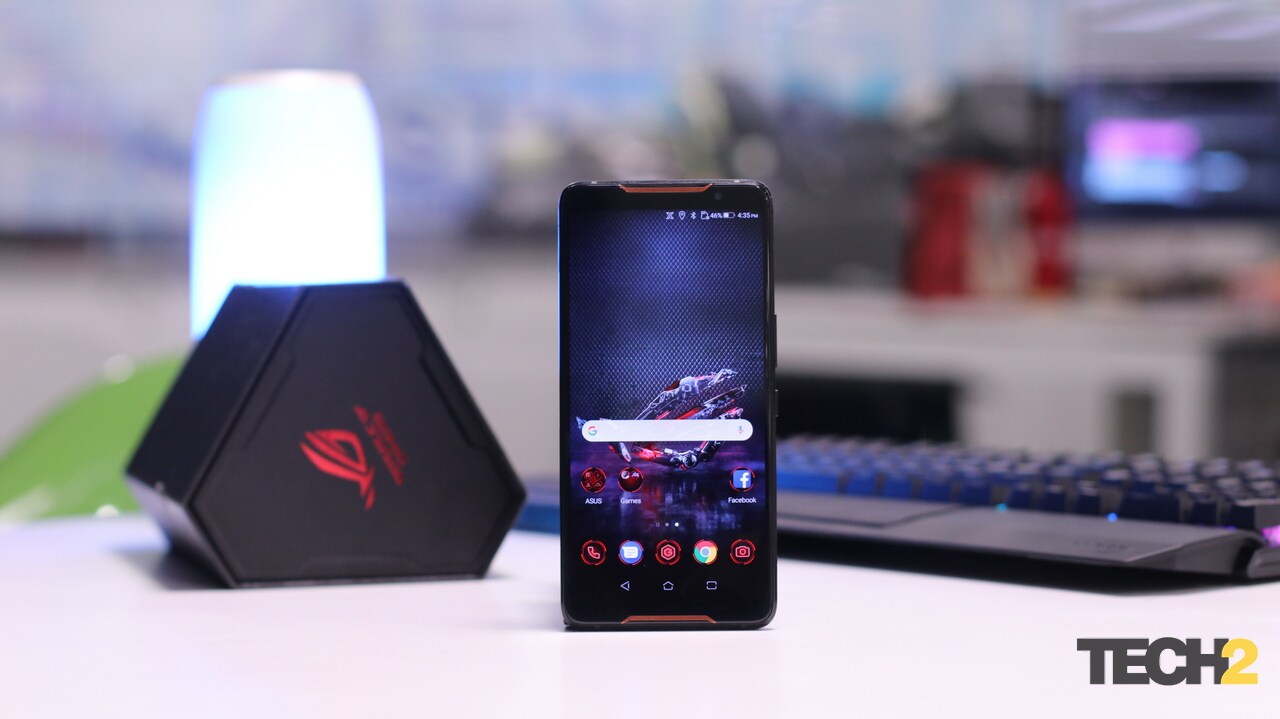
It's nice to see a notch-less display for a change. Image: tech2/Shomik
On the front you see a notch-less display flanked on the top and bottom by copper-accented speaker grills. The bezels on the phone aren’t as thick as say the Razer Phone and it provides for a great viewing experience.
It can be said that Asus did not spare any expense in making the phone as appealing to the gaming population as possible from the outside.
Asus ROG Phone Features: 8.5/10
The ROG Phone is packed to the brim with features, most of which help in the performance of the device. For one, the phone comes with an X-mode which provides the user with all kinds of software tweaking options to boost gaming. This is similar to the ROG software which comes bundled with ROG motherboards and laptops, which helps with quick overclocking and the tweaking of performance levels.

The ROG Phone has a proprietary port on the side along with another type-C port. Image: tech2/Kshitij Pujari
The sides of the phone are pressure sensitive and you can customise them to open different apps with a longer squeeze or shorter squeeze. As mentioned above these sensors also double up as 'air triggers", giving you an extra set of buttons while gaming.
Under the hood, you have an overclocked and one of a kind Qualcomm Snapdragon 845 SoC which can be found coupled with 8 GB of DDR4 RAM and 128 GB of UFS 2.1 storage. Basically, this is a fast phone and it shows while operating the device. More on that later.
A great display is something any gaming phone should have and Asus has done a good job with the screen. The phone has a 6-inch AMOLED display with a refresh rate of 90 Hz making the browsing, navigation and more importantly, the gaming experience on the phone feel extremely smooth. Most good smartphones manage around 60 Hz.
Audio is another important factor in determining a good gaming phone and Asus has packed in a DTS:X 7.1 surround sound feature to make for an audio-rich viewing experience. If headphones are not your forte then the dual-speakers on the phone will certainly blow your mind.
The side of the phone comes with a USB Type-C port, which is useful for charging your phone while gaming in a horizontal mode without cable interference. Beside that is a proprietary Asus port which handles a wide assortment of accessories that Asus is providing, including the Aeroactive cooler (provided in the box), TwinView Dock, GameVice, Desktop Dock and more.
Here's brief on what each accessory is all about:
- TwinView Dock: The TwinView Dock essentially gives your ROG Phone a second screen. This can be used to stream games on the go while responding to your subscribers. Also, the TwinView Dock, which features the same display as the ROG phone, also includes an additional trigger button and a humungous 6,000 mAh battery. The accessory costs Rs 21,999 in India.
- GameVice: This is similar to the Nintendo Switch's Joyconn controllers, except that both controllers on the GameVice are held together by a strap. The GameVice will cost Rs 5,999 in India
- ROG Desktop Dock: For serious gamers, the ROG Desktop Dock is the perfect companion as it allows you to attach a mouse, keyboard, a 4 K monitor and more. It costs Rs 12,999 in India.
- Professional Dock: This is a toned down version of the Desktop Dock and has fewer ports along with only 1080p support. It costs around Rs 5,499 in India.
In the camera department, we see that the ROG Phone packs in the same camera setup as was seen on the ZenFone 5Z, which is a 12 MP sensor with an f/1.8 aperture primary camera and an 8 MP secondary camera. On the front for selfies, we see an 8 MP camera with fixed focus. The phone has a 4,000 mAh battery powering it with dual-SIM support, 4G VoLTE, Wi-Fi, GPS, Bluetooth, NFC and a 3.5 mm headphone jack. The phone supports Quick Charge 3.0 on the port on the bottom and Quick Charge 4.0 on the side port. And before you ask, no, you can’t charge the phone from both ports.
Asus ROG Phone Display: 8.5/10
The ROG Phone has a gorgeous display and the fact that they have incorporated a 90 Hz refresh rate on an AMOLED panel tells me that Asus really cares about quality viewing on its phone. It’s just one of those things that you can’t appreciate till you have experienced it. Having only used a 60 Hz display all my life, I was stunned at how smooth an interface can become at 90 Hz. I can only imagine what the 120 Hz display on the Razer Phone 2 must look like. A better refresh rate means smoother transitions and fluid gameplay, both of which are sure to give you an edge over opponents while gaming. Asus also says that the ROG Phone can reproduce 108 percent of the DCI-P3 colour gamut, which does make the colours look more vibrant and punchy. If the wide colour gamut is not your cup of tea, you can always switch to the standard mode.
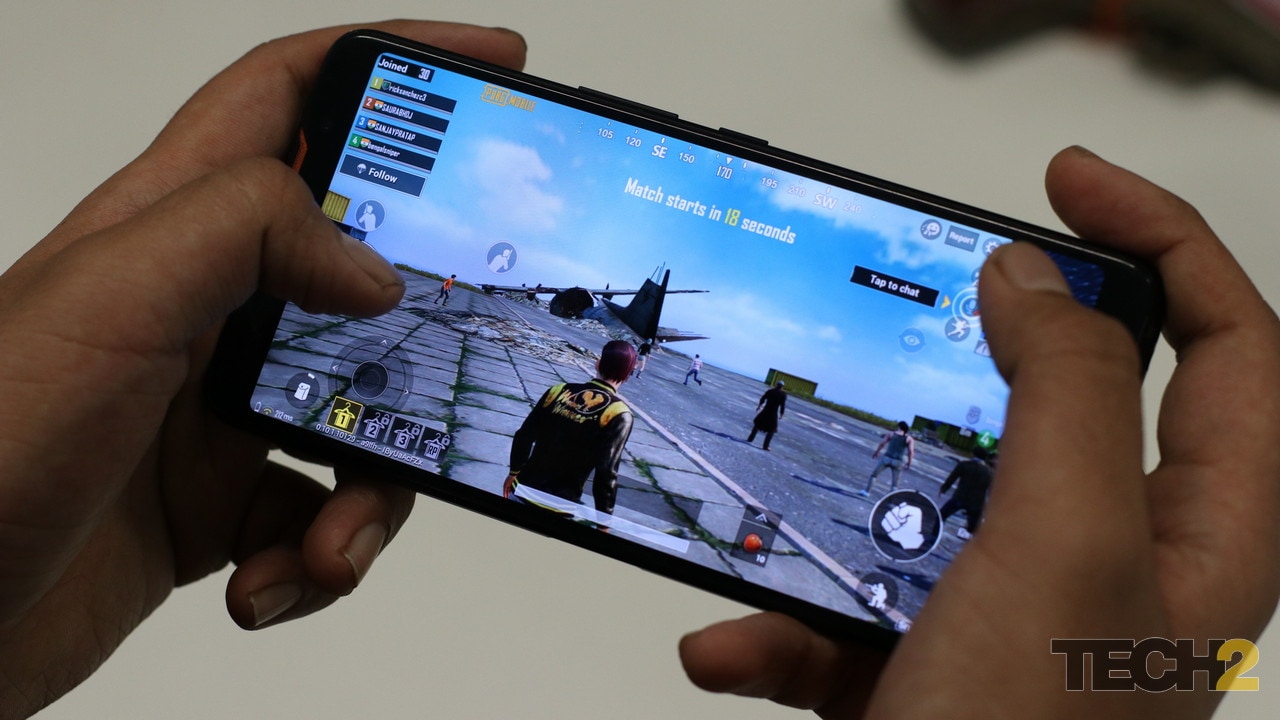
This is the first smartphone to come in India with a 90 Hz display. Image: tech2/Kshitij Pujari
The ROG Phone supports HDR streaming capabilities so you can watch your favourite shows on Netflix, Prime Video and Hotstar at the best video quality on offer. One thing I did notice was a pale yellowish tinge on the screen when it was viewed at an angle. While this is common on most smartphones with an OLED display, the ROG Phone exhibits a far greater tint than I would’ve liked. In any case, it was not concerning for me as a regular user would rarely be using the phone tilted like that. The phone is bright enough and I was surprised at how legible the screen was even under bright sunlight conditions. During night time the brightness goes down to acceptable levels and Asus has also included a blue light filter for ease of reading during low light conditions.
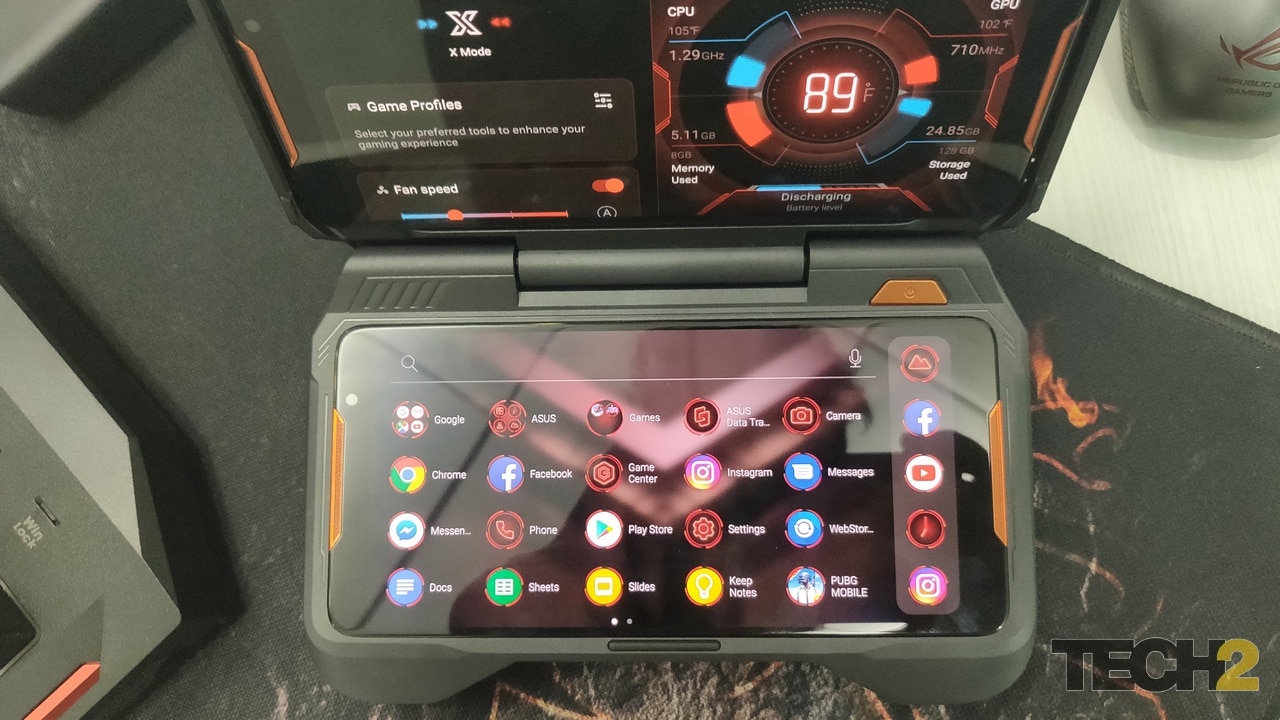
The TwinView Dock turns your phone into a Nintendo DS-like console. Image: Tech2/Kshitij Pujari
The display also has an always-on mode and Asus has included some cool, gamer-themed clock and notification skins. The display alone justifies the price tag of this phone. The 90 Hz refresh rate does make for smoother transitions, which are necessary for a game like PUBG Mobile where a microsecond lag could result in a life or death situation.
Asus ROG Phone Software: 8/10
The ROG Phone is all about gaming and the software that Asus has implemented speaks for it. To start with, the experience is more or less stock Android. This means that there is next to no bloatware, no unnecessary UI experimentation and more importantly (for me at least) there’s an app drawer. Apart from that, Asus has included custom skins and themes to make the whole interface very reminiscent of its ROG laptop lineup. Then there’s the X-Mode which has its own tab in the notifications bar at the top and can also be activated via a long squeeze on the phone. X-Mode works like any other gaming mode on other smartphones by freeing up RAM and clearing the cache. However, it also opens the Game Centre which has a tonne of customisation options available, many of which are unheard of in a smartphone.

The ROG Phone has quite the clean UI.
Game Centre lets you make a custom profile for all games on your smartphone. For instance, under PUBG Mobile’s profile, I can choose the maximum CPU frequency, adjust anti-aliasing, change the alert system and automatically clean cache memory to load the game faster. For lighter games such as Temple Run or Angry Birds, clock speed can be set low so that battery is used less. This will be the default settings for each game so that you can allocate higher performance to heavier games and lower performance to lighter games. In general, the Game Centre will show you the CPU and GPU temperatures and their clock speeds along with temperatures. You can also change the fan speed of the Aeroactive Cooler when it is attached to the phone. The backlit ROG logo, which Asus calls Aura Lighting, can be set to a custom colour and supports light effects like breathing, strobing, static and colour cycle.

ROG Phone Game Center and lock screen.
Asus has nailed the software of the ROG Phone and it has even provided tools for streaming, configuring the air triggers, allocating RAM, etc. What's more, you get all the AI-enabled features that were introduced on the Asus ZenFone 5Z.
Asus ROG Phone Camera: 6/10
Now I know that the ROG Phone isn’t a camera phone, however, if you are spending Rs 70,000 on a device you would expect it to have a decent camera. While the latter is mostly true for the ROG Phone, there are a few areas where the phone struggles.
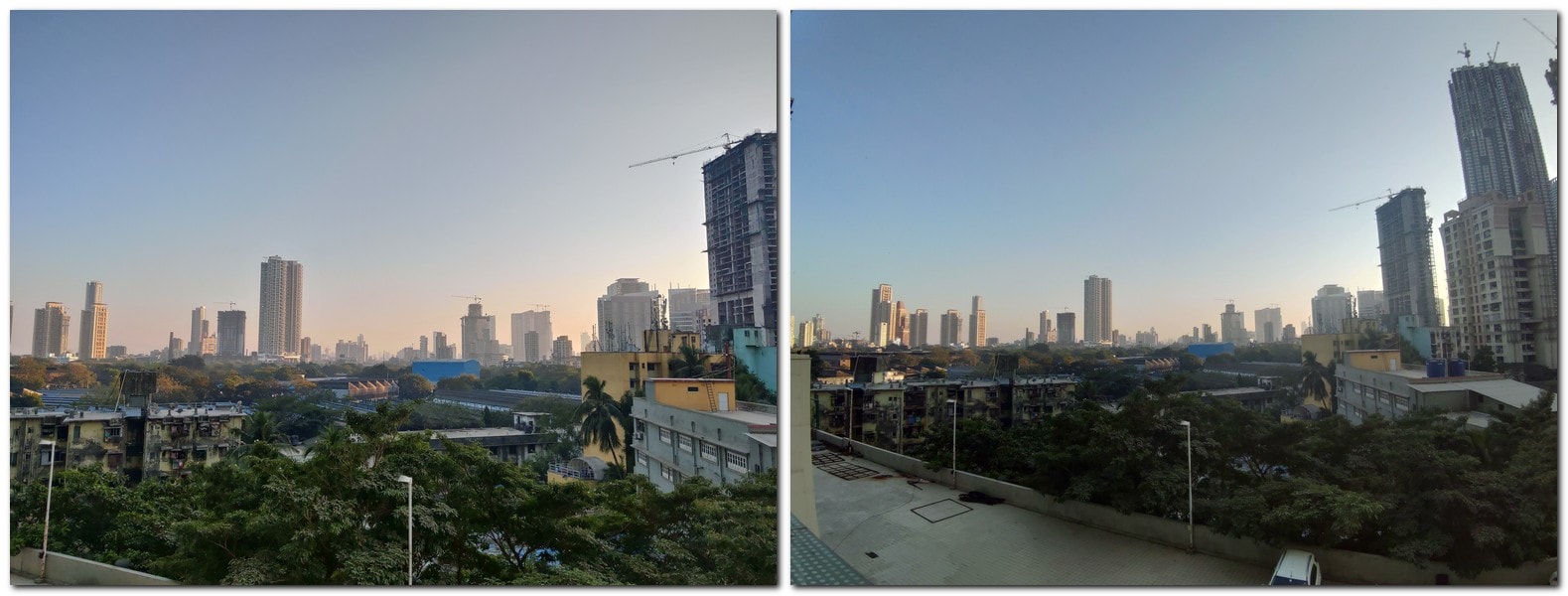
Normal photo (L) vs Wide Angle photo (R)
The phone comes with a 12 MP primary sensor with an f/1.8 aperture and OIS and an 8 MP wide-angle secondary camera. This is the same setup we have seen on the Asus ZenFone 5Z and while that phone clicked good pictures, it is also half the price. That’s where the problem is. The camera on the device is certainly not at par with the other heavy end flagships such as the Samsung Galaxy Note 9, Google Pixel 3 and the Apple iPhone XR.

Asus ROG Phone (L) vs OnePlus 6T (R)
Photos clicked lack depth and details. The HDR on the phone is average as compared to the OnePlus 6T in a side-by-side photo comparison. The wide-angle lens on the phone is good but fails against the LG G7 ThinQ, which again is slightly more than half the ROG Phone’s price. The same is true for video taking capabilities on the phone. Night time shots are quite bad with no focus and wayward exposure. The wide angle lens is good, but again, details are absent in the photo.
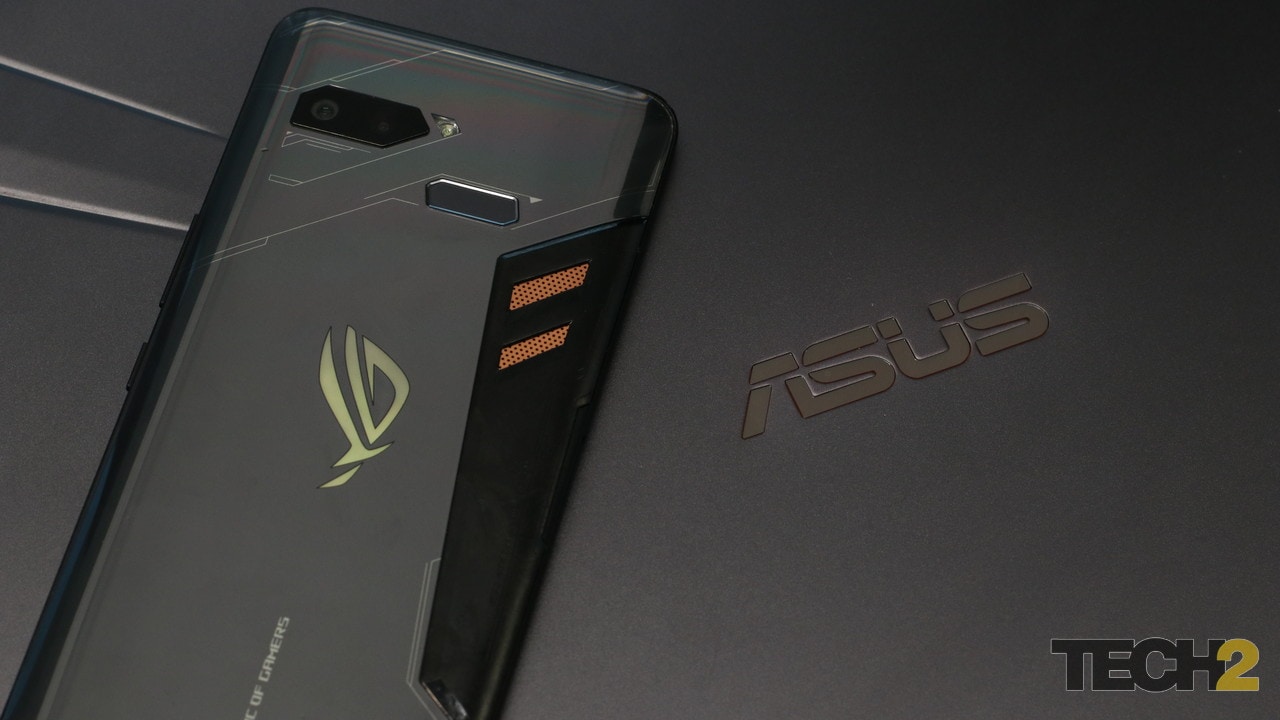
Asus has a massive eco-system of gaming laptops. Image: Tech2/Kshitij Pujari
Again I’ll reiterate that as a gaming phone, the ROG Phone ticks off all the boxes. But it is not an impressive camera phone. Yes, it takes good pictures, but so does the Poco F1 or the Honor 10 or the OnePlus 6T, all of which cost substantially less. The bottom line is that if you are looking for a good camera phone, this is not the ideal choice.
Asus ROG Phone Battery: 6/10
Gaming phones are supposed to have great battery life. However, that was not true for the ROG Phone, which is surprising since it has a 4,000 mAh battery. I was using the ROG Phone as my daily driver for more than a week and consistently got about four and a half hours of screen on time, and this is without gaming. Gaming gives the phone somewhere around 3 hours of screen on time.

Battery drain on the ROG Phone.
I suspected that the 90 Hz display was soaking in most of the battery so I turned the refresh rate back to 60 Hz and found that the battery jump was not substantial. On X-mode, the battery drained even faster and that’s kind of sad since the X-Mode does not do anything significant, performance wise.
You will need to charge your phone after some intense sessions of gaming and even if you watch just videos, the phone is not likely to last the entire day. Speaking of which, the battery does charge quite fast thanks to Qualcomm Quick Charge 4.0. When compared to OnePlus 6T's dash charging, the phone does charge marginally faster. The ROG phone's 4,000 mAh battery took 13 minutes to go from 25 percent to 50 percent. On the OnePlus 6T, 25 percent to 50 percent took 16 minutes, and bear in mind that that 6T has a smaller, 3,700 mAh battery.
Verdict and price in India
In terms of the gaming experience and raw performance, the ROG Phone can do no wrong. It is the perfect visual blend of design and aesthetics. Combined with the number of accessories that Asus provides, no other phone on the market can offer what the ROG does. Sure, the Razer Phone and Xiaomi Black Shark could present some serious competition, but they're not available in India.
However, there is obviously the question of whether you need all these features that Asus provides? The 90 Hz display is cool, but you can get by with the 60 Hz on a OnePlus 6T. The dual-speakers and audio on the device are loud and immersive, but the LG G7 ThinQ’s speaker and audio quality are just as good. The vapour cooling on the ROG can also be found on the Poco F1.
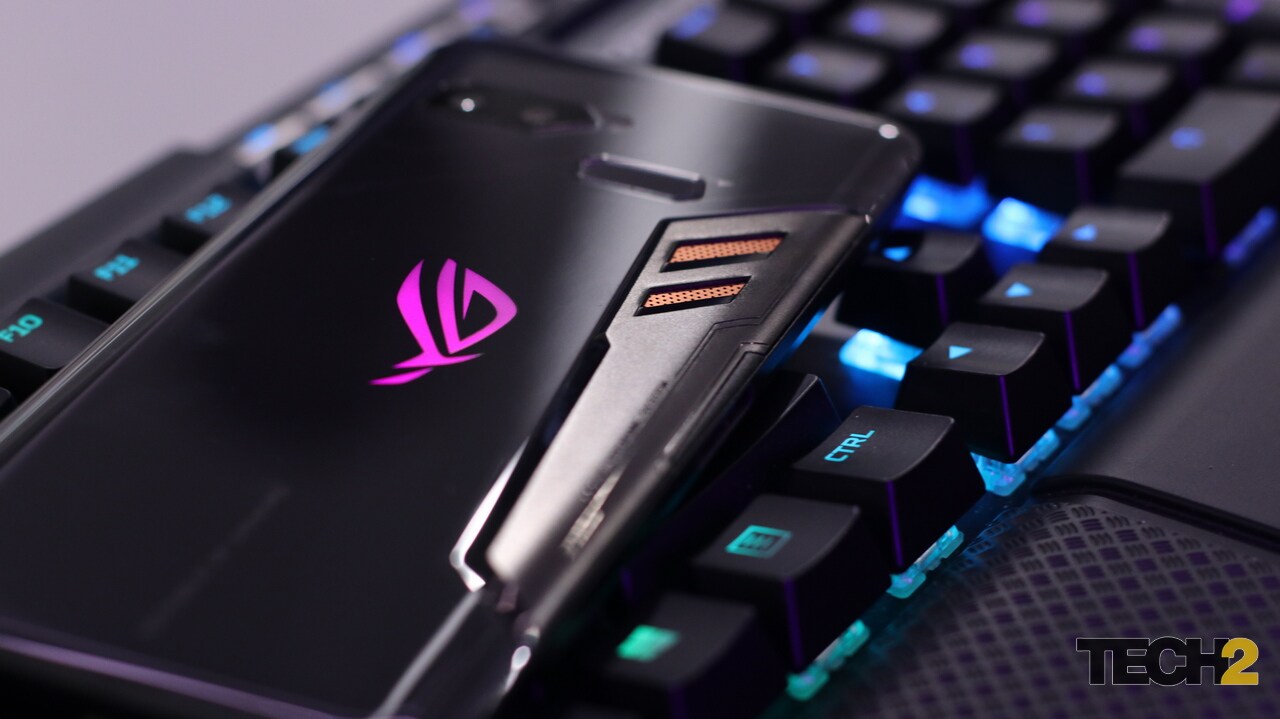
Undoubtedly Asus has made this phone to appease the gamer mind. Image: tech2/Shomik
The battery is average and the camera is poor, both of which are much better on an equally priced Note 9 or Huawei Mate 20 Pro. The real reason you'd buy the Asus is to get the wide range of accessories that could certainly help in gaming.
The Asus ROG Phone is certainly going to appeal to a lot of high-end gamers who would love to see the ROG Phone go along with their other fancy hardware. The PUBG Mobile experience is surreal on the ROG Phone and there’s no denying that. However, if playing on a better device made you a PUBG Mobile champ, then everyone would be rushing for gaming devices. The question you need to ask yourself is whether you'd spend Rs 70,000 on a gaming phone when a Rs 20,000 phone will give you 90 percent of the experience. That’s a decision that we can't help you make.

Image: Tech2/Kshitij Pujari
Yet another factor that may have escaped your attention is that an iPhone XR will offer an even better gaming experience while still offering a stunning camera, display and stereo speakers. It's also far more powerful than the ROG phone can ever hope to be. And now with the Snapdragon 855 mere months away, even an overclocked Snapdragon 845 won't be able to compete.
Tech2 is now on WhatsApp. For all the buzz on the latest tech and science, sign up for our WhatsApp services. Just go to Tech2.com/Whatsapp and hit the Subscribe button.
Source
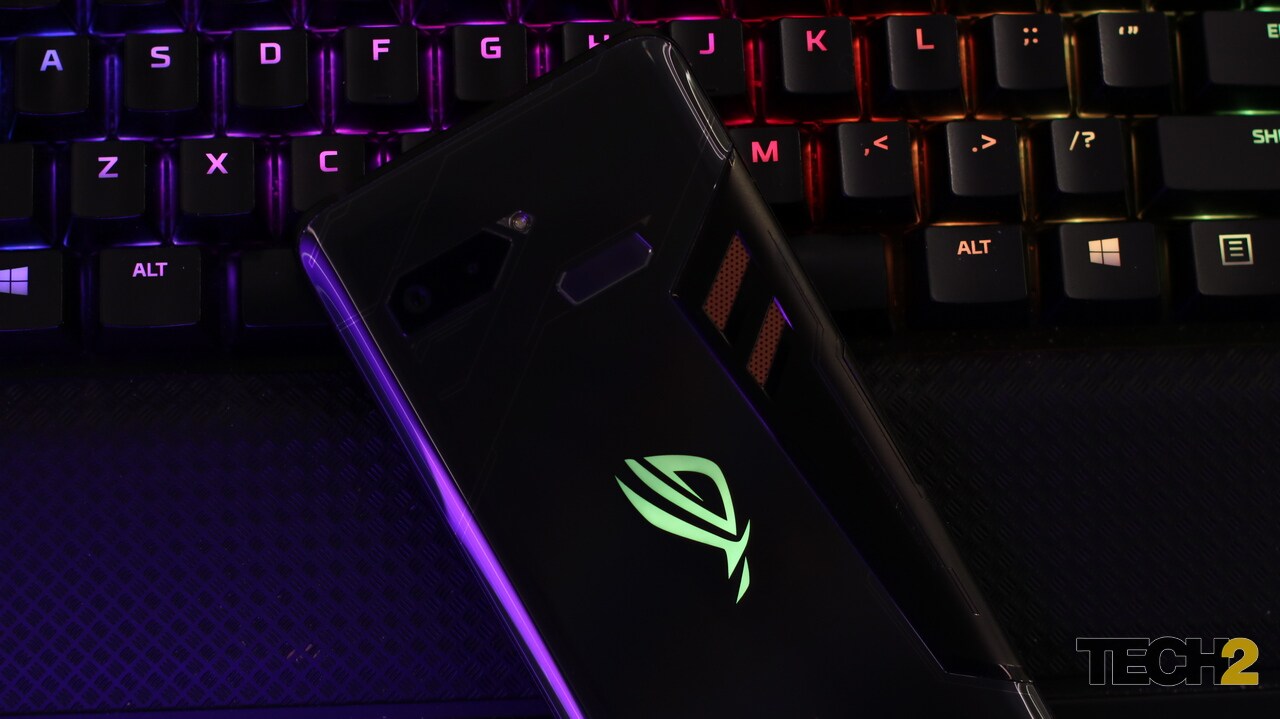

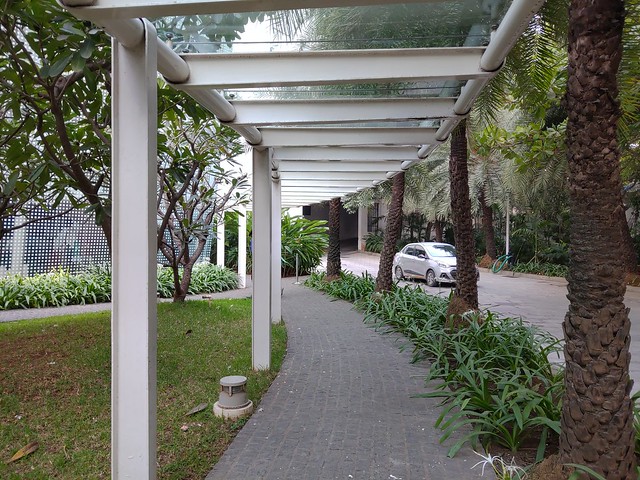

No comments: